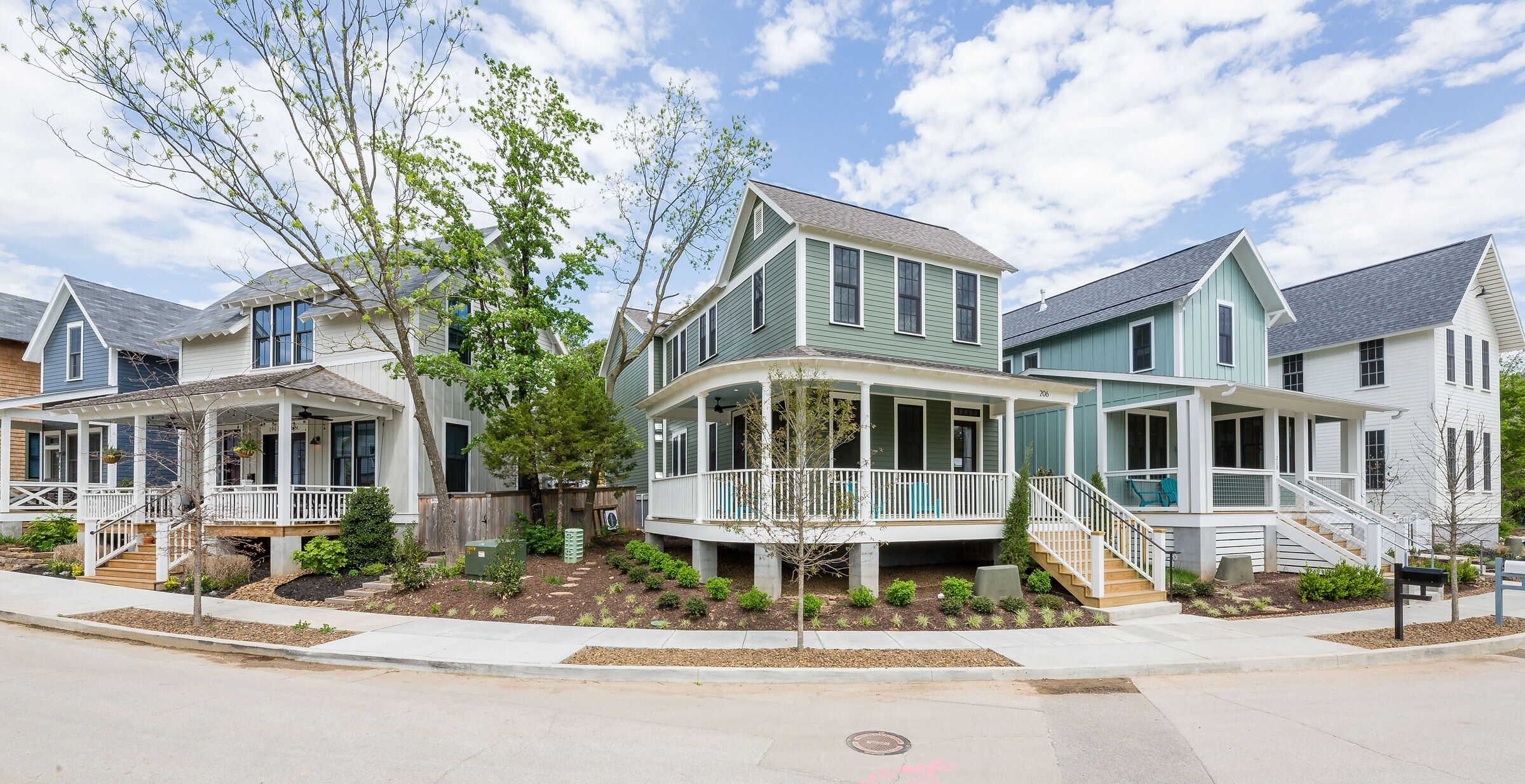Basic principles are often overlooked by developers.
By Allison Thurmond Quinlan
SOUTH STREET COTTAGES: A project in Fayetteville from the author’s firm.
The demographics of developers (and bankers and appraisers and general contractors and city planners and engineers and all the other ecosystem partners that make buildings happen) are fairly consistent. As an architect, landscape architect, land planner and small developer in Northwest Arkansas, I am regularly the only woman in a room of white males. My economic, cultural and social expectations tend to match most of the industry, but even my slight deviation from the standard practitioner provides for a sometimes radically different viewpoint on the business of development.
Primarily, I try to build and design places that people love. This starts with caring about people. I will admit, that isn’t always an easy job. Feedback from the public is often very charged and challenging for developers. But in the general public’s defense, there’s been a lot of bad development in the last 60 years in America. And people hate ugly things. This observation has led my work to be centered around two fairly basic ideas that some male developers would be embarrassed to even suggest out loud: Build cute things that people like and be kind to people with your projects.
People are so used to ugly, boring projects that they will forgive a multitude of sins (like no covered parking, coat closets or powder rooms) when the project is really cute. We have made an entire business of building cute houses that people love, in a walkable location where they want to be, in exchange for space and storage people often do not even need. These houses are not for everyone, but two-thirds of households are made up of 1-2 people. That share of households is rising year by year as the number and presence of children in households continues to drop. And, if someone wants a four-bedroom house on a large lot, they already have plenty to choose from on the market. Small, attractive houses in walkable locations close to businesses, however, are severely underbuilt and highly in demand. One of our cutest projects was four 500-square-foot, one-bed, one-bath houses built by 3V Development on Ninth Street in Fayetteville on a typical 50-by-150-foot downtown corner lot. By virtue of being small and using very little land, the houses can be sold for a relatively affordable total purchase price (the mortgage payment on a 30-year loan is affordable by federal standards for someone making 80 percent of the area’s median income). The price per square foot is high, but the houses were the least expensive new-construction homes sold in downtown Fayetteville by a wide margin. All sold for asking price within three days of hitting the market. 3V is now building and selling the plan from a wait list.
LAVENDER: Developers should consider planting medicinal or edible herbs.
At our own self-developed South Street Cottages, we designed each phase with a “loss leader” design item — something located in a high visibility area that would delight residents and neighbors alike. Exposed rafter tails have a unique profile on each house, and broad front porches expand small interior footprints (800-1,900 square feet) to the street. Including garage apartments behind some houses also provided an opportunity to add density and diversity to the homes without impacting the character of the street.
Being nice to people is a broad directive, but you have a wide opportunity to follow it. Build connected networks of streets so neighbors don’t have to drive around your project. Build nice porches so people have a shady, nice spot to sit outside and neighbors have something interesting to walk by. Design buildings that are practical and easy to build to be nice to your contractors. Build connected sidewalks to be nice to older folks and young parents pushing strollers. Install dog doors to fenced yards so people don’t have to put a leash on their dog at 3 a.m.. Think about ways to make people’s lives easier and execute them. When working with ERC Co. on THRIVE Argenta, we softened the sidewalks with fragrant and edible herbs instead of sterile turf grass. Rosemary, lavender and sage make a daily walk by the building more beautiful and relaxing, and residents and neighbors alike can snag a few sprigs to add to their dinner. When Ozark Natural Foods moved back downtown into a 1960s sprawl pattern building surrounded by parking, we worked with Modus Studio to provide a massive protected porch, raised above the traffic of College Avenue and enclosed with a series of planters filled with native plants that are either edible or medicinal. The enclosure allows parents to let their kids safely play while they have a coffee or local beer, while the planting provides eye-level interest to pedestrians on the adjacent sidewalk.
Being kind to people with your projects does not have to be expensive. Many of the things we use to accomplish this goal don’t add much if any cost to the project. Once you start noticing how many ways you can be kind to people with a project, much of the built world will become infuriating to use. You’re welcome.
Building very cute housing in walkable locations that are kind to people is excellent business sense. It’s also functionally illegal in most places. You may note that the zoning code in your municipality was first passed around 1968. This was the year the Fair Housing Act made it illegal to openly discriminate against people, and zoning came to be used in Arkansas to discriminate against people more subtly. We now, like many others, find ourselves unsurprisingly short of affordable and attainable housing. We also find ourselves with the opportunity to exercise not just kindness but also long overdue fairness by removing these systemic barriers to equal access to housing and wealth creation.
Allison Thurmond Quinlan is the founder of Flintlock Architecture & Landscape in Fayetteville.



